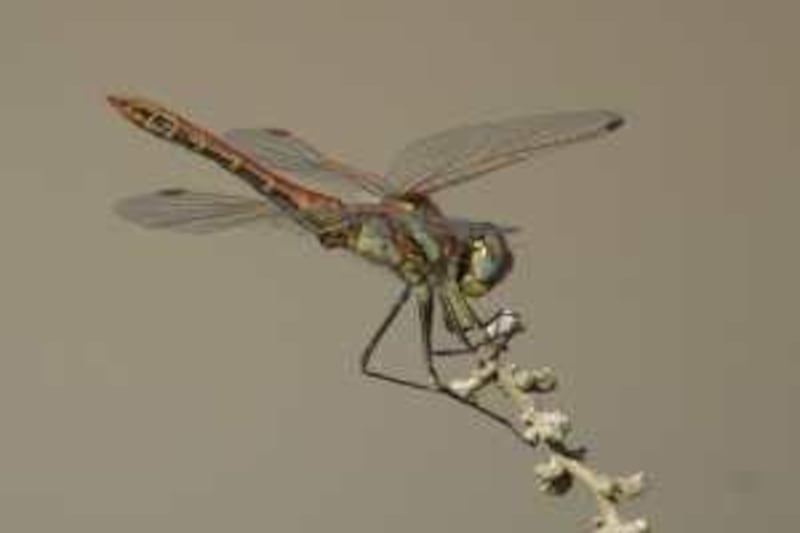ABU DHABI // For the past few weeks, a curious natural phenomenon has been unfolding across the country. The red-veined darter, a dragonfly that was unknown in the UAE just a decade ago, has been spotted in unprecedented numbers in locations as far apart as Abu Dhabi, Al Ain and Kalba.
Until very recently, there had been fewer than six UAE sightings of the insect, whose Latin name is Sympetrum fonscolombii; in the second half of this month alone, there were more than a hundred. Oscar Campbell, a science teacher based in the capital, is one of the few people keeping track of the phenomenon. "I actually saw one individual on Lulu island, in Abu Dhabi, on October 30," he said. "Unfortunately I did not get pictures, so could not be sure of its identity.
"However, when I saw two at Kalba on November 14, I did get pictures, and the Lulu one was a dead ringer for them. There is no doubt about the identity of it now. It was the Kalba records that opened the floodgates." Mr Campbell, a keen birdwatcher and a member of the Emirates Bird Records Committee, counted 19 individuals during a visit to the Mushrif Palace Gardens on November 19, and another three at the same location two days later.
The next day, he counted six during a visit to Al Wathba wetland. Many more were found in Al Ain, at sand dunes by Jebel Hafeet. Last week, at least 15 were seen around the capital. "We have seen between 100 and 150 insects in the last two weeks," he said. "The record books have been rewritten." The red-veined darter is widespread across southern Europe, much of Africa and parts of the Middle East but is rare in the UAE.
According to an article in Tribulus, a scientific journal published by the Emirates Natural History Group, the insect's presence in the UAE was suspected as early as 2000. However, the first published record did not come until 2003. In January of that year Bernhard Herren, a Swiss birdwatcher with a special interest also in dragonflies, visited the country on a birdwatching trip. "We were walking behind the stables for the cows in Fujairah's National Dairy Farm late in the morning," he recalled.
"There were three little ponds because it had been raining the days before and it was warm enough for them to be flying around. "I had about half an hour to look around and then I saw it. It was definitely a male. You can tell by the eyes and the blueish reflection of the upper body. Females are far less spectacular." At the time, Mr Herren did not realise he had seen something special. He had recognised the dragonfly as similar to ones in Switzerland, but it was only when he returned home and shared his discovery with a knowledgable friend in Bern that he learned it had never been recorded in the UAE.
"He told me to write a short record," Mr Herren said. "Which I did." His article, in German, was published in the journal Notulae Odontologicae later that year, and the red-veined darter had officially arrived. But why, suddenly, are they here with such a vengeance? Perhaps, according to Mr Campbell, because of the paucity of previous studies. The UAE's records are relatively recent, and lack enough information to form a reliable baseline.
"In the 1990s, probably not many people were looking," he said. "The more people looking, the larger the chance of spotting one. But I would still say the influx is very unusual." Once people know what to look for, the insects are relatively easy to identify. "Whilst there are several species of reddish dragonflies, you can recognise this species by the fact that the abdomen is rather slim, the eyes are half red and half grey-blue and, if you are close, the wing vixens are stained reddish," Mr Campbell said. "Also, they perch a lot, mostly basking in the sun, and so are easy to approach."
Colonies of breeding dragonflies are usually close to water, but as the red-veined darters are only migrating through the UAE, they can be seen in more diverse areas. "As these are migrants, you can see them anywhere," Mr Campbell said. "Any sunny areas with low vegetation to perch on, in towns and cities, and in the desert, may attract them. "They must be occurring at lots of other places too; it is just that nobody is noticing them. I guess that many thousands, at least, are migrating through the UAE right now".
Mr Campbell suggested the influx could be linked to a large population build-up of the insects in Asia. "After a wet spring provided lots of temporary habitat for breeding, those insects, or their offspring, are now migrating south in response to colder conditions," he said. Anitha Kumari Saji, a research associate in entomology at the Environment Agency-Abu Dhabi, expressed a similar hypothesis.
"Migration is the most probable reason suspected of this increase now," she said. "But in the UAE dragonfly movements are very poorly understood." Around 27 species of dragonflies are known to exist in the UAE, Mr Campbell said. More than half of them breed here, with the rest passing through as they wander over thousands of kilometres. Dragonflies have two pairs of transparent wings and an elongated body. They are characterised by their large eyes.
"If the same scale was applied to humans, our eyes would be as large as basketballs," Mr Campbell said. The insects' large eyes and strong wings make them a difficult prey. Only some birds such as the hobby, a small falcon, and the bee-eater are able to catch them. Dragonflies are themselves carnivorous, eating mosquitoes and other small insects. "They are more like the lions of the insect world, rather than the zebras," said Mr Campbell.
@Email:vtodorova@thenational.ae lhecke@thenational.ae






